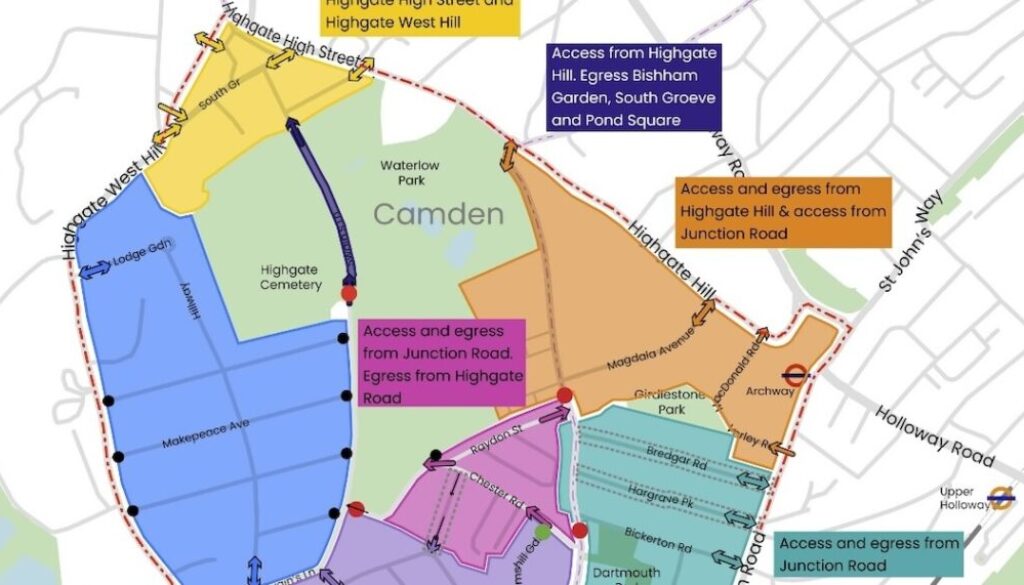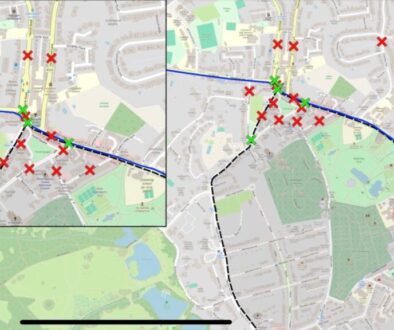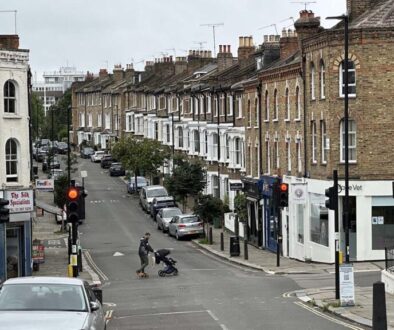A Planners perspective
Dartmouth Park Healthy Neighbourhood Scheme
A contribution by Robert Dolata MRTPI (Retd)
The views expressed are those of the author
Consultation process
The consultation is not legitimate. It is being run during summer holidays, immediately after a General Election which engaged and exhausted many. It excludes people travelling for holidays and those that prefer daylight evenings outdoors to zoom meetings, workshops and consultation documents. It must be extended until end October 2024 to provide adequate time for residents and affected businesses to comprehend the impact of the scheme proposals.
Certain features, such as local one way schemes, road closures and so on have been proposed before – up to 20 years ago, only to meet vehement protest and sustained opposition. As a result those schemes were withdrawn.
The various documents available online are superficial in description and extremely difficult to follow on a computer screen. The .pdf “Dartmouth Park Area Healthy Neighbourhood proposal overview” – 23 pages – appears to be the most comprehensive, but provides summary information only. Descriptions do not set out precisely what is proposed at various locations. There is no comprehensive schedule of proposals, referenced to one map, setting out specifics of where, what, when, benefits and above all cost. Illustrations and descriptions of potential schemes are required to understand what is meant by “improvement”, “enforced filter” and so on.
To comprehend the suggestions and understand the impact of the scheme as a whole it would be necessary to visit each location and walk the entire area. This is not possible given other commitments particularly at this time of the year.
Local Councillors must get a grip and immediately put a brake on roll out. Timely, convenient public meetings and public locations with display boards presentations are vital to engage, involve and obtain the support of constituents.
Background
Brief description of the scheme
The scheme comprises a range of installations in the road, camera enforced controls, one-way arrangements and road closures. Their purpose is to deter vehicles from driving through the area and discourage local vehicle journeys in favour of walking and cycling. These measures aim to improve the environment and social health.
History
Various authorities brought forward traffic schemes locally during the 1960s and 1970s to assist traffic flows. Public interest eventually inspired change in government policy away from facilitating through traffic.
Specifically:
- 1960s Archway southbound Highgate Hill North Hill northbound one-way system – withdrawn. The proposed scheme inspired the foundation of the Highgate Society
- 1970 / 1980s Archway Road widening abandoned after 3 public inquiries (George Stern & Nina Tuckman were objectors)
- 1980s Chetwynd Rd / Dartmouth Park Road one way system – withdrawn
- 2000s Extension of controlled parking hours – withdrawn
Project Formulation
The documents supporting the scheme do not follow conventions for highway and town planning – that is to set out the objectives, evidence, propose alternatives with evaluation, and an assessment of the impact on interests, protected and vulnerable groups.
Independent examination is mandated if property and economic well-being is disadvantaged.
The project could be challenged for flawed preparation. For example the project should Identify:
What is the objective of this project
What is the problem it is trying to solve
Have objectives other than traffic control and environmental control been defined such as those listed below:
- Reduce visual clutter
- Maintain and conserve Victorian street character (especially pavements, gutter setts which assist percolation of surface water into the soil, permeable road surfaces)
- Define roads for vehicles, and pavements for people, visually and clearly
- Reinforce safety; facilitate kerb drill for children
- Ensure good visibility and sight lines
- Educate cyclists not to abuse pavements
- Avoid costly measures which are expensive to maintain, or require technical support such as camera enforcement
- Engage community participation, support and consensus
- Engage stakeholders, particularly schools and children
- Recognise that vehicle transport is important for people:
- with limited mobility who may not meet disability criteria
- who cannot walk distances or cycle in a hilly area
- who are transporting children and the elderly
- carrying shopping and heavy materials especially uphill
Scheme design should allow for:
- Visitors
- Deliveries including bulky materials, erecting scaffolding etc.
- Fire brigade access with escape ladders
- Enable rapid access for firefighting, police, and ambulances
- Protect access for street utilities and repair
Designs must avoid opportunities for criminal and anti social behaviour such as drug dealing and concealment, and through running on mopeds to dodge police pursuit.
Scheme planning
Schemes must be sound, and:
- founded on objective independent evidence which follows recognised methodologies
- supported by a consensus of public opinion
- consistent with regional and other local planning
- avoid spillover impacts on neighbouring areas
- legally compliant
Artificial schemes contrived to generate revenues through charges and penalties are not legally acceptable.
Schemes should not cause congestion or queuing detrimental to local environments and functions.
Traffic network modelling should identify issues and avoid costly redesign.
Get it right first time. Experimental schemes incur cost of removal.
Public consensus is desirable.
Evidence
Traffic evidence usually comprises counts and surveys to establish flows, timing and the purpose of journeys. Origin destination, mode, purpose, time, frequency are typical data inputs for modelling existing and predictable effects of measures. Traffic generators e.g. health, religious, retail, leisure, education should be surveyed and consulted.
Evidence would also include parking, residential, business, on and off street; essential users access requirements, and unsocial hours, such as for medical workers.
Political factors
Political representatives must avoid setting one street’s residents against another.
Councillors and local government officers are bound by the Nolan principles
Selflessness, Integrity, Objectivity, Accountability, Openness, Honesty and Leadership.
A perception of untoward council familiarity with consultants and contractors or technical sympathy would be concerning.
Schemes such as low traffic neighbourhoods are challenged because realities of local access routes are not recognised.
Public and political attention is focused on local government finance for Social Care, Children and Families, Education. Significant expenditure on consultants and highway schemes is politically damaging, irrespective of regulatory restriction on use of parking related road traffic revenues to transport projects.
The changed Labour government is eager to project technical competence, effectiveness and reliability.
Alternative uses for road traffic revenues
Notwithstanding, restrictions on use of parking etc. revenues, there are alternatives for transport related schemes spending. Hampstead and Highgate is a newly redefined parliamentary constituency, but access across it is poor given separation by open spaces, notably Hampstead Heath.
A new bus service joining up Muswell Hill, Highgate Village, Kenwood and Hampstead is particularly necessary.
Other schemes could include:
- Roll out of fast chargers for electric vehicles
- Community road safety training, including safer driving and awareness
- Improvements to road and street environments that respect, conserve and enhance the Victorian environment which includes many sustainable features that are not understood and appreciated today. E.g. safety roadside kerbs, granite setts laid with gaps that allow surface water to percolate rather than overwhelm sewers
- Removal and rationalising signage where it adds to visual clutter and obstructs sightlines
- Removing traffic lights installed interim to subsequent general reductions in road traffic – e.g. Chetwynd Road / York Rise.
- Repair potholes especially beside road humps.
It is unfortunate that scheme developers have not acknowledged the considerable reduction of road traffic accomplished over recent years. Their proposals appear excessive given the degrees of local traffic. Roads such as Dartmouth Park and Chester Road are comparatively quiet, with much reduced traffic even at peak hours.
As an alternative to the range of schemes proposed, organic development of minor schemes to address local problems with measurable impact assessment is suggested. These could be developed with community bottom up involvements, e.g. through community grants and incentives.



